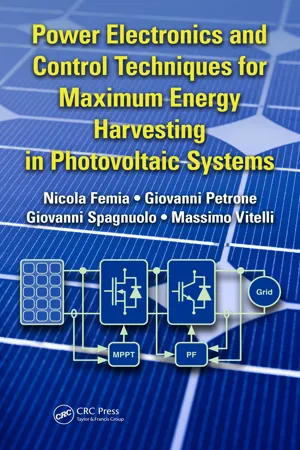
Power Electronics and Control Techniques for Maximum Energy Harvesting in Photovoltaic Systems
- 366 pages
- English
- ePUB (mobile friendly)
- Available on iOS & Android
Power Electronics and Control Techniques for Maximum Energy Harvesting in Photovoltaic Systems
About this book
Incentives provided by European governments have resulted in the rapid growth of the photovoltaic (PV) market. Many PV modules are now commercially available, and there are a number of power electronic systems for processing the electrical power produced by PV systems, especially for grid-connected applications. Filling a gap in the literature, Power Electronics and Control Techniques for Maximum Energy Harvesting in Photovoltaic Systems brings together research on control circuits, systems, and techniques dedicated to the maximization of the electrical power produced by a photovoltaic (PV) source.
Tools to Help You Improve the Efficiency of Photovoltaic Systems
The book supplies an overview of recent improvements in connecting PV systems to the grid and highlights various solutions that can be used as a starting point for further research and development. It begins with a review of methods for modeling a PV array working in uniform and mismatched conditions. The book then discusses several ways to achieve the best maximum power point tracking (MPPT) performance. A chapter focuses on MPPT efficiency, examining the design of the parameters that affect algorithm performance. The authors also address the maximization of the energy harvested in mismatched conditions, in terms of both power architecture and control algorithms, and discuss the distributed MPPT approach. The final chapter details the design of DC/DC converters, which usually perform the MPPT function, with special emphasis on their energy efficiency.
Get Insights from the Experts on How to Effectively Implement MPPT
Written by well-known researchers in the field of photovoltaic systems, this book tackles state-of-the-art issues related to how to extract the maximum electrical power from photovoltaic arrays under any weather condition. Featuring a wealth of examples and illustrations, it offers practical guidance for researchers and industry professionals who want to implement MPPT in photovoltaic systems.
Frequently asked questions
- Essential is ideal for learners and professionals who enjoy exploring a wide range of subjects. Access the Essential Library with 800,000+ trusted titles and best-sellers across business, personal growth, and the humanities. Includes unlimited reading time and Standard Read Aloud voice.
- Complete: Perfect for advanced learners and researchers needing full, unrestricted access. Unlock 1.4M+ books across hundreds of subjects, including academic and specialized titles. The Complete Plan also includes advanced features like Premium Read Aloud and Research Assistant.
Please note we cannot support devices running on iOS 13 and Android 7 or earlier. Learn more about using the app.
Information
Table of contents
- Cover
- Half Title
- Title Page
- Copyright Page
- Dedication
- Table of Contents
- Preface
- About the Authors
- 1 PV Modeling
- 2 Maximum PoweRpoint Tracking
- 3 MPPT Efficiency: Noise Sources and Methods for Reducing Their Effects
- 4 Distributed Maximum PoweRpoint Tracking of Photovoltaic Arrays
- 5 Design of High-Energy-Efficiency Power Converters foRpV MPPT Applications
- Index